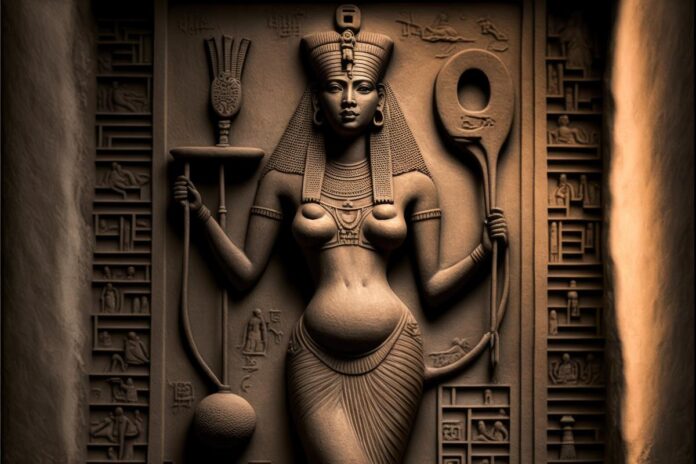The sistrum was one of the most sacred musical instruments in ancient Egypt and was believed to hold powerful magical properties. It was used in the worship of the goddess Hathor, a mythological character associated with joy, festivity, fertility, eroticism, and dance. The sistrum was also shaken to avert the flooding of the Nile and to frighten away Seth, the god of the desert, storms, disorder, and violence. Isis, depicted as a mother and creator, often held a pail symbolizing the inundation of the Nile in one hand and the sistrum in the other. Its design was meant to replicate the sound of the breeze hitting and blowing through papyrus reeds, but its symbolic value far surpassed its musical significance.
Ancient Greek historian, Plutarch, discussed the influential role of the sistrum in his essay, “On Isis & Osiris”:
“The sistrum makes it clear that all things in existence need to be shaken, or rattled about, and never to cease from motion but, as it were, to be woken up and agitated when they grow drowsy and torpid. They say that they avert and repel Typhon by means of the sistrums, indicating thereby that when destruction constricts and checks Nature, generation releases and arouses it by means of motion.” (Plutarch, Moralia, Book 5, “On Isis & Osiris,” section 63)
The sistrum consisted of a handle and frame made from materials such as brass, bronze, wood, or clay. When shaken, the small rings or loops of thin metal on its movable crossbars produced a range of sounds from a soft rattle to a loud jangle. Its basic shape resembled the ankh, the Egyptian symbol of life, carrying the hieroglyph’s meaning. Archaeological findings have revealed two distinct types of sistrum.
The oldest type of sistrum is naos-shaped, with the head of Hathor often depicted on the handle and the horns of a cow incorporated into the design. Known as the ‘naos sistrum’ or ‘sesheshet’, this sistrum dates back to at least the Old Kingdom (3rd millennium BC) and was frequently carried by women of high rank in ancient Egyptian art.
Nefertari, wife of Ramesses II, holding a sekhem-type sistrum. (Public Domain)
During the Greco-Roman Period, a simpler sistrum known as sekhem or sekham gained popularity, featuring a hoop-like frame made from metal. This type of sistrum resembled a closed horseshoe with a long handle and loose metal cross bars above the Hathor head.

A priestess with the sekhem sistrum. (Public Domain)
In ancient Egypt, the sistrum was used in the musical worship of various deities, but it was especially associated with the worship of Hathor, the great goddess. It was used in rituals, dances, worship, and celebrations dedicated to Hathor, often carrying erotic or fertility connotations linked to the goddess’s mythological attributes.

Fragment of a sistrum, 26th dynasty. Sistrum in the name of a priestess of Bastet, Late Period, (664-332 BC) (anonymous/CC BY-SA 2.0 FR)
The use of the sistrum continued even after the rule of the pharaohs in Egypt, spreading further with Rome’s conquest of the region in 30 BC. The worship of the goddess Isis became widespread in the Greco-Roman period, with temples dedicated to her built across major cities. The sistrum became closely associated with Isis during this time.

Marble statue of Isis, the goddess holds a situla and sistrum, ritual implements used in her worship, from 117 until 138 AD, found at Hadrian’s Villa (Pantanello), Palazzo Nuovo, Capitoline Museums. (Public Domain)
Today, sistra are still utilized in the rituals of the Coptic and Ethiopian churches.
Top image: Statue of Hathor, goddess of love, music, and fertility with sistrum and hieroglyphs – AI generated. Source: Iarte/Adobe Stock
By Joanna Gillan
This article was first published in 2014 and was updated by an Ancient Origins editor in Nov 2024.




